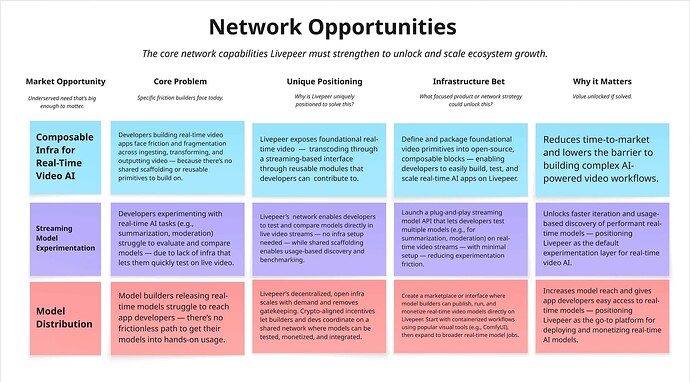Hi everyone,
We’re excited to share a critical part of the Advisory Board process: aligning on a Go-To-Market (GTM) strategy.
This phase brings together insights from the Network and Growth Boards to sharpen our shared understanding of the biggest opportunities ahead and the bets we’ll make to capture them.
The Role of Advisory Boards
To recap, Advisory Boards are small groups of trusted contributors working to shape the long-term direction of the Livepeer project. They bring deep, hands-on experience across key domains — Network, Growth, Governance, and Capital Markets — helping identify challenges, set priorities, and surface actionable paths forward.
The goal is to strengthen the Livepeer protocol through clearer long-term planning and tighter alignment on near-term focus areas. By involving more contributors in strategy-setting, we’re building a stronger, more resilient foundation for the ecosystem to grow and evolve.
GTM: Critical Cross-Board Alignment
Each board has its own area of focus, but the work of bringing Livepeer to market sits at the intersection of both Network and Growth.
For this phase, we focused on creating a shared 6-12 month GTM direction around:
- Network Opportunities - the core network capabilities Livepeer must strengthen to unlock and scale ecosystem growth. This gives focus to new and existing core contributors.
- Ecosystem Opportunities - Demand-generating use cases uniquely enabled by the Livepeer network. This gives focus to new and existing builders.
This shared GTM is important because it combines the shared expertise of both boards and implements a more holistic strategy at both an infrastructure and application level.
Methodology
Board members worked asynchronously to draft GTM bets that Livepeer could pursue over the next 6–12 months. Each submission answered:
- Why this bet could generate demand
- Why Livepeer is uniquely positioned to pursue it
- Example use cases that bring it to life
Rick and Rich (I know), the Chairs of the Network & Growth ABs, then conducted several rounds of analysis, synthesis and review to summarise the GTM themes:
Both the Network and Growth Boards then came together for a structured session to refine and align on the GTM landscape.
Boards discussed proposed bets and opportunities, then voted on priorities. Following the workshop, board chairs and the Livepeer Foundation synthesised the data into two categories: Network and Ecosystem opportunities. Let’s dive into them below.
Network Opportunities
Boards identified three core network bets that would meaningfully reduce friction for developers and unlock scalable, repeatable value across the ecosystem:
- Composable Infrastructure for Real-Time Video AI - Open-source building blocks that reduce integration complexity and speed up development cycles.
- Streaming Model Experimentation - Plug-and-play APIs for testing and benchmarking AI models in live, production-like environments.
- Model Distribution - Interfaces for containerized, real-time models to be published, discovered, and monetized.
These are infrastructure-first moves that will lower adoption barriers and position Livepeer as a core platform for real-time video AI.
Ecosystem Opportunities
Boards aligned on several high-potential GTM opportunities where Livepeer is uniquely positioned to serve meaningful demand:
- Real-time AI Video Analysis at Scale - For applications like threat detection, content moderation and sports analytics.
- Real-time Generative Video Experiences - Powering next-gen user experiences through synthetic or AI-enhanced video output.
- Open Video Infrastructure for Decentralized Social - Underpinning new social platforms that need real-time, censorship-resistant media tooling.
- AI-Powered Video Agents as Economic Actors - Enabling autonomous agents that generate, interpret, or trade video-based content.
A future-facing opportunity emerged around synthetic worlds and simulation-based content, including use cases such as generative gaming, robotics training environments, and immersive AI-generated video.
While not yet a standalone GTM priority, this theme aligns tightly with Livepeer’s strengths in scalable, permissionless GPU compute.
For now, it’s integrated into the broader Generative Video Experiences track, but we’ll keep monitoring it as a potential long-term bet.
What’s next: Final stages of Advisory Boards
After this additional GTM workshop, Advisory Boards focused back in on the final task of the process: developing Tactical Recommendations.
These are concrete, actionable initiatives that can be executed over the next six months to advance their strategic pillars. These recommendations will be refined collaboratively, prioritized based on feasibility and impact, and connected to measurable outcomes.
The Foundation is in the final stages of Tactical Recommendation synthesis and will publish the boards’ findings next week.
Finally, the Foundation will publish a full synthesis of board inputs, incorporating final recommendations into a cohesive network roadmap. This will include sequencing, coordination across domains, and early signals on capital allocation priorities.
CTA: Build the future of Livepeer
The GTM strategy workshop was an addition to the central advisory boards process and we thank the board members for their hard work put in, often at evenings and weekends, to make it happen.
We’re proud to show you the fruit of their labour and to hear your feedback on the network and ecosystem opportunities they have prioritised.
If you’re a builder or core contributor, reach out to the Livepeer Foundation to see how you can get involved in the next steps.
The Foundation team,
Rich, Ben, Rick, Joseph and Ven.


